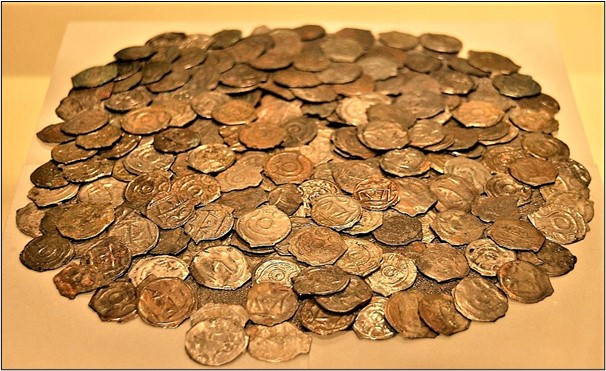By Ken Battle
Lists of Iron Age hoards in Great Britain make reference to the ‘Sunbury’ Hoard, but a more accurate description would have been the Shepperton Hoard. The confusion arose when Mr. A.J. Buttress, the Surveyor for the Sunbury Urban District Council, reported the discovery in April 1950 to the old London Museum, who unfortunately recorded the find as being at Sunbury, not Shepperton. The hoard of 317 whole coins and pieces of 56 others, dating from 100-50 BC, was buried in three pottery vessels and became one of the largest hoards of Iron Age coins ever found in Britain. The Staines & Ashford News for Friday, 14th April 1950, reported the find as follows:
“Rainbow Corner” Treasure Find – Council Workmen find Hoard of Coins
Two Council workmen digging “two spits deep” on the piece of ground used as a nursery for plants at “Rainbow Corner”, Acacia Avenue estate, on Wednesday [12th April], turned up a vase containing more than 200 copper and bronze coins. The site of the “treasure” was on the corner of Jessiman Terrace where the link road joins Acacia Avenue to the estate. They broke the vase, which was less than 2 ft. below the ground. Mr. A.J. Buttress, the Council’s Surveyor, has taken charge of the matter over which enquiries will have to be made. The coins are about the size of sixpences and believed to be earlier than Roman times. They have no legible markings. Mr. Buttress thinks they are not Roman. Other opinions at the Council Offices include “They might be valueless”.
Following a Coroner’s inquest on the find, the coins proved not to be treasure trove and they were handed back to the Council. The ‘heads’ and ‘tails’ of the coins represent a stylised human head, originally the god Apollo, and a butting bull. They are made of Potin, an alloy of copper, tin and lead, which makes them amenable to casting rather than struck from dies. The use of moulds enabled several coins to be cast at the same time before separation into individual coins. The Shepperton find remains the most westerly hoard so far discovered and one of the only two hoards preserved intact. Following advice from the London Museum, the Council decided that the hoard should remain on permanent loan to the Museum, who eventually provided replicas of six coins and one of the pots in which they were found. These were on display in Shepperton Library for a number of years and can now be seen at the Spelthorne Museum, Staines. Just why the hoard was buried and never retrieved will forever remain a mystery.

